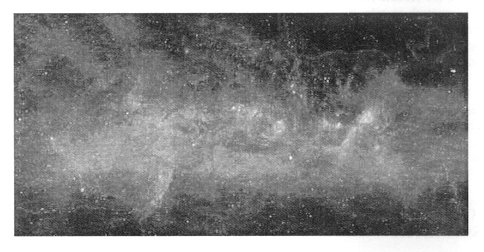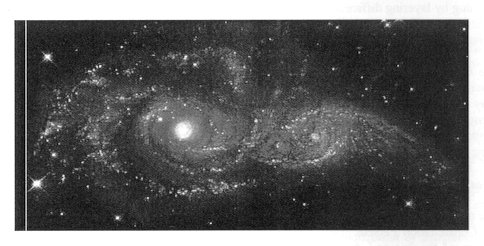|
COSMOS VERSUS CANVAS:
JAYANNE ENGLISH
Name: Jayanne English, Assistant Professor (Astronomy and Physics), Astronomer and Artist (b. Toronto, Ont., Canada). Address: Department of Physics and Astronomy, University of Manitoba, Winnipeg, Manitoba, Canada R3T 2N2. E-mail: jayanne_english@umanitoba.ca Fields of interest: The structure and evolution of galaxies, astronomical image-making, public outreach (installation art). Awards: Hubble Heritage Project (as Project Coordinator), 2000; Infinity Award from the International Center for Photography. Publications and/or Exhibitions: English, J. (1992) Constructing truth using algorithms, Third International Symposium on Electronic Arts, Sydney. English, J., curator (1996) SoftCopy/HardCopy, [Exhibtion and Workshops], Kingston Artists' Association's Modern Fuel Gallery, [An exhibition on the boundary between art and science]. English, J. (2000) No Virginia, the Hubble Space Telescope doesn't take colour snapshots, Cassiopeia, December Solstice 2000, No. 107, CASCA Publication: http://www.casca.ca/ecass/issues/winter2000/coverWinter2000.html Elmegreen, B. G., Elmegreen, D. M., Kaufman, M., Brinks,
E., Struck, C., Thomasson, M., Klaric, M., Levay, Z., English, J., Bond,
H. E., Christian, C. A., Frattare, L. M., Hamilton, F., Noll, K. S. (2000)
HST observations of the interacting galaxies NGC 2207 and IC 2163, Astronomical
Journal, 120, P630 [This is an example of a professional paper that
uses a public outreach astronomy image; other professional astronomy papers
are listed at the NASA ADS abstract website.]
Abstract: Colour images created from telescopes
are extraordinary ambassadors for astronomers. Yet astronomical images
are a battlefield where scientific meaning all but subverts visual literacy.
Interestingly, a symmetric astronomical survey can generate dissymetric
images. For the astronomers the dissymmetry constrains the number of active
physical processes. However, scientific curiosity in the public viewer
is piqued only if the image-makers generate a symmetry between the way
images are perceived and this scientific meaning. Therefore, artists should
be included in this battle between the culture of science and the culture
of visual art over the visualization of astronomical data. This will ensure
that both sides win.
1 PUBLIC OUTREACH IN ASTRONOMY WITH STRIKING IMAGES Colour images from the Hubble Space Telescope, for example, are considered to be extraordinary ambassadors between the lay public and professional astronomers. Images produced the Hubble Heritage Team, like NGC 2207 & IC 2163 (see References), are striking enough to win the 2000 Infinity Award for Applied Photography from the International Center for Photography. Yet such images are a battlefield where the badgering of scientific nomenclature plus accumulated biases all but drown out the voice of visual literacy. The NASA images have traditionally been produced by individual
scientists, or their research group, and most news images are recycled
from scientific papers. As observatories become more international, the
construction of public outreach images becomes more collaborative. Yet
rarely does an artist hold a place on the image-making team.
2 CONSTRUCTING MEANING AND THE SIGNIFICANCE OF DISSYMETRY Creating a one-to-one analogue with visual reality is not a goal for scientific image-makers. Rather they attempt to delineate only selected physical processes or limited characteristics of the subject being studied. Computers are used to construct the intended meaning by layering different black and white images of data which have been chosen to highlight specific phenomena. A colour-coded symbol system is created for each layer in a final image and this legend differs for each image. The Canadian Galactic Plane Survey, which examines the material between stars, can provide an example. Since this interstellar matter is concentrated in a plane in our Milky Way Galaxy, an equal distance above and below the middle of this plane is surveyed. Many black and white images are generated from these data. One black and white image, say associated with the plane's cold gas, may be assigned the colour blue. An image at the same location but of dust, heated by the radiation from young stars, may be colour-coded red. Then the colour images are combined together and the location of the colour purple reveals which gas clouds are polluted with dust. The meaning in a map constructed in this way, such as "Midplane of the Milky Way near the Constellation Perseus" (see References), is distinct for different audiences. The texture of the gas and dust scanned through the symmetrical window of the survey produces a dissymmetrical and rather abstract image. This pleasantly invites the general viewer to project their own meaning and associations upon it. Yet for the astronomers intimate with the survey, the dissymmetry constrains the number of possible physical processes acting upon the material between stars.
Midplane of the Milky Way near the constellation Perseus
Interacting Galaxies NGC 2207 & IC 2163
3 A SYMMETRY OF INTENDED MEANINGS AND THE ROLE OF ARTISTS As the artist on the Hubble Heritage Team, I raised formal perceptual concerns related to creating an engaging image that would have meaning for the public. As an astronomer, I understood my colleagues' desire to re-create, in photographic-like form, a contour plot that uses highly contrasting colours and intensities to delineate physical phenomena. This latter type of image would have meaning for those who knew the associated symbolic legend. I believe our team demonstrated that sometimes in this battle, between the culture of science and the culture of visual art over the visualization of Hubble Space Telescope data, both sides win (English 2000). More than forging a relationship between art and science, some of these pictures, and the Canadian Galactic Plane Survey images, are objects that are simultaneously artworks and scientific results. Yet the artistic voice should be represented more frequently.
Although the data are esoteric and riddled with detector artifacts, much
of it is available in public archives. The challenge is for interested
artists to comprehend the data sufficiently in order to achieve an equilibrium
in meaning, a symmetry of intent. Then one can manifest a concrete object
that is recognized as valid in both disciplines.
References Public Release image of NGC 2207 & IC 2163 is available at http://heritage.stsci.edu/public/99nov4/displayingc2207.html Public Release image of "Midplane of the Milky Way near the Constellation Perseus" is available at http://www.ras.ucalgary.ca/CGPS/press/aas00/pr/pr_14012000/pr_14012000map1.html English, J. (2000) No Virginia, the Hubble Space Telescope
doesn't take colour snapshots, Cassiopeia, December Solstice 2000,
No. 107, CASCA Publication: http://www.casca.ca/ecass/issues/winter2000/coverWinter2000.html
|

